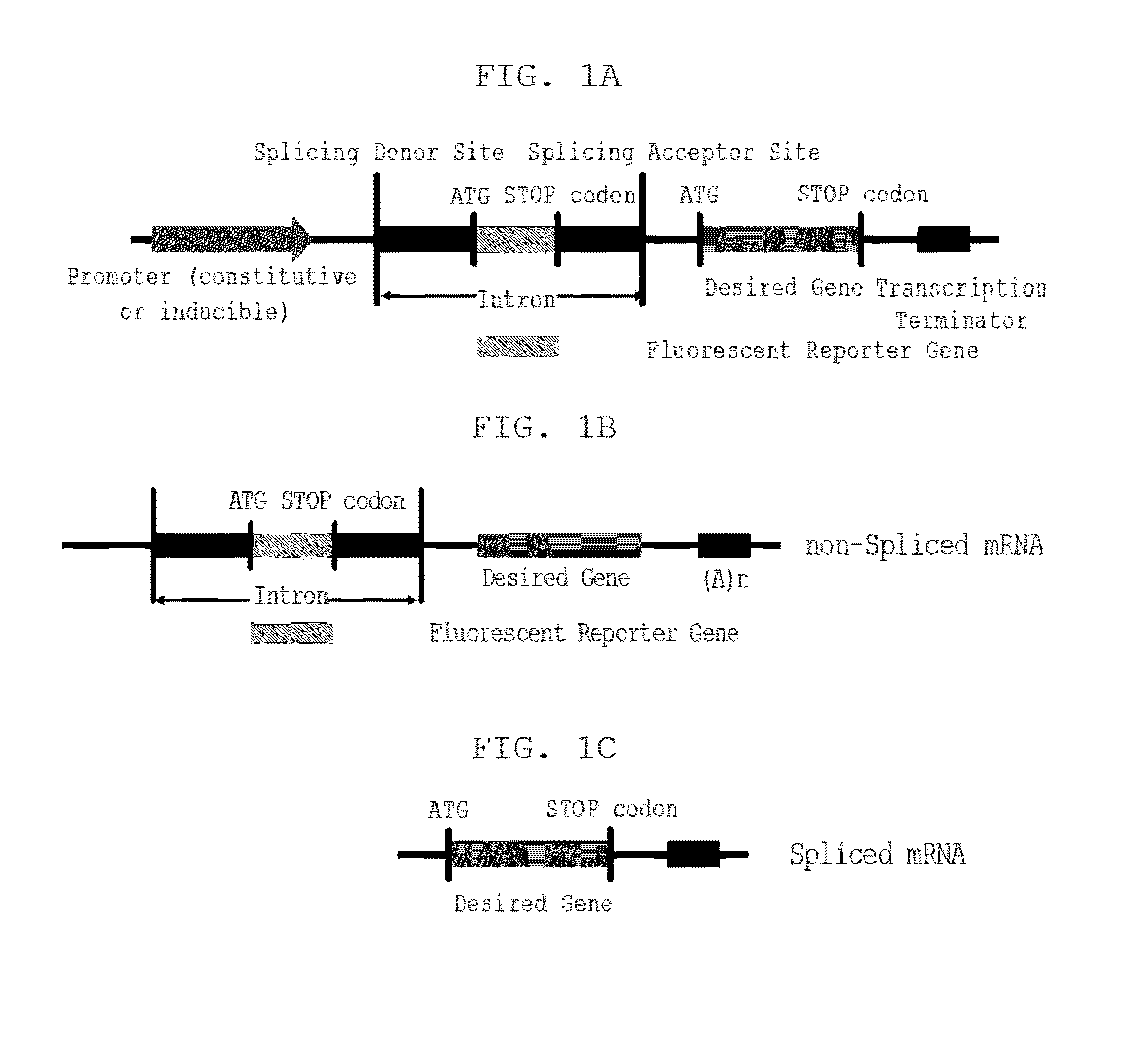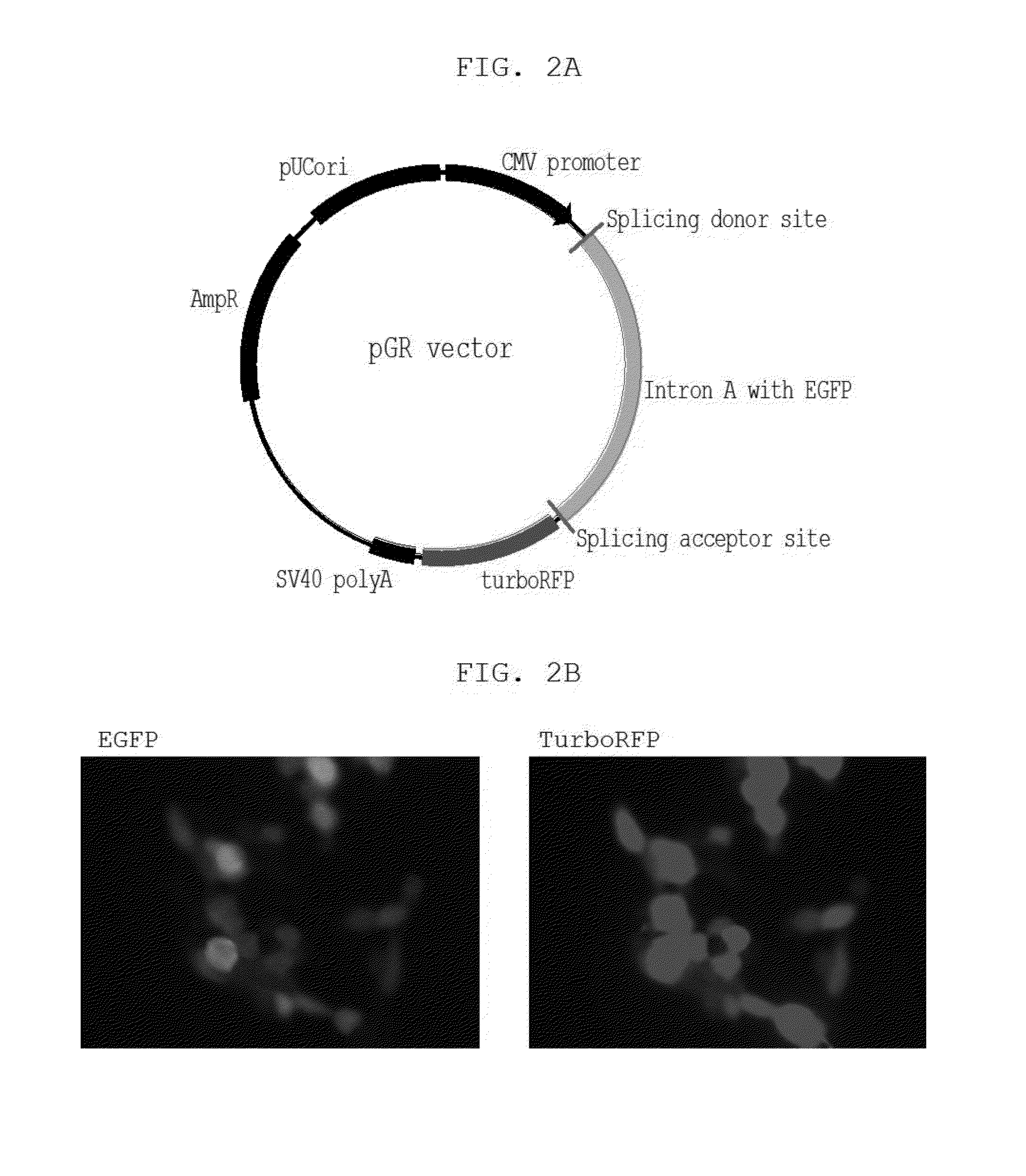DNA construct and method for transgene expression
a technology of dna constructs and transgenes, applied in the field of dna constructs and methods for transgene expression, can solve the problems of high cost and ineffectiveness of known methods for inserting dna segments into eukaryotic host cells, large proportion of host cells surviving selective pressure do not have the desired product, etc., to achieve rapid and convenient operation, easy identification
- Summary
- Abstract
- Description
- Claims
- Application Information
AI Technical Summary
Benefits of technology
Problems solved by technology
Method used
Image
Examples
example 1
An Intronic Enhanced Green Fluorescent Reporter (EGFP) is Capable of Indicating Expression of Desired Product
[0063]In order to determine if a fluorescent reporter positioned within an intron can be expressed efficiently and be used to indicate expression of a desired gene, the enhanced green fluorescent reporter gene (EGFP) is inserted into an intron, while a red fluorescent protein (turboRFP) gene is positioned at 3′-terminus of the intron splicing acceptor site as a representation of desired genes. The transcription of both genes is regulated by a single promoter and a unique transcription terminator in a constitutive way. After introducing the vector into mammalian cells, fluorescent EGFP and turboRFP are expressed and analyzed by a fluorescent microscope.
1. Vector Construction:
[0064]The vector for constitutive gene expression is illustrated by FIG. 2A. A single human cytomegalovirus (CMV) promoter regulates expression of turboRFP and EGFP in a constitutive way. The enhanced gree...
example 2
An Intronic TurboRFP Fluorescent Reporter is Capable of Indicating Expression of Desired Product
[0074]In order to prove the possibility of other intronic fluorescent reporter as an indicator of expression of desired products, the turboRFP gene was inserted into an intron as a reporter, while the EGFP gene was positioned at 3′-terminus of the intron as a representation of desired genes. The transcription of both genes is regulated by a single promoter and a unique transcription terminator in a constitutive way. After introducing the vector into mammalian cells, fluorescent turboRFP and EGFP are expressed and analyzed by a fluorescent microscope.
1. Vector Construction:
[0075]The vector for constitutive gene expression is illustrated by FIG. 3A. Expression of turboRFP and EGFP are regulated by the CMV promoter. The gene encoding turboRFP is positioned within the intron A sequence from the human cytomegalovirus immediate-early gene. The gene encoding EGFP was placed at 3′-end of the spli...
example 3
Inducible Expression of Enhanced Green Fluorescent Protein (EGFP) in Human Embryonic Kidney (HEK293) Cells
[0082]In order to investigate intronic fluorescent proteins as reporters for inducible expression of a desired gene, a DNA construct of the invention is incorporated into an inducible expression vector. The resulted vector is transduced to a population of host cells. In the absence of an inducer, neither the fluorescent reporter nor the desired product is expressed by the host cell. In the presence of an inducer, the fluorescent reporter is expressed by the transgenic host cell. A host cell having a phenotype of the fluorescent reporter should also produce the desired product.
1. Vector Construction:
[0083]The lentiviral vector for inducible expression of the reporter and desired gene is illustrated by FIG. 4A. Expression of turboRFP and EGFP are inducible and regulated by a single operable linkage comprising the tetracycline response element (TRE) and a minimal CMV promoter. The ...
PUM
 Login to View More
Login to View More Abstract
Description
Claims
Application Information
 Login to View More
Login to View More - R&D
- Intellectual Property
- Life Sciences
- Materials
- Tech Scout
- Unparalleled Data Quality
- Higher Quality Content
- 60% Fewer Hallucinations
Browse by: Latest US Patents, China's latest patents, Technical Efficacy Thesaurus, Application Domain, Technology Topic, Popular Technical Reports.
© 2025 PatSnap. All rights reserved.Legal|Privacy policy|Modern Slavery Act Transparency Statement|Sitemap|About US| Contact US: help@patsnap.com



